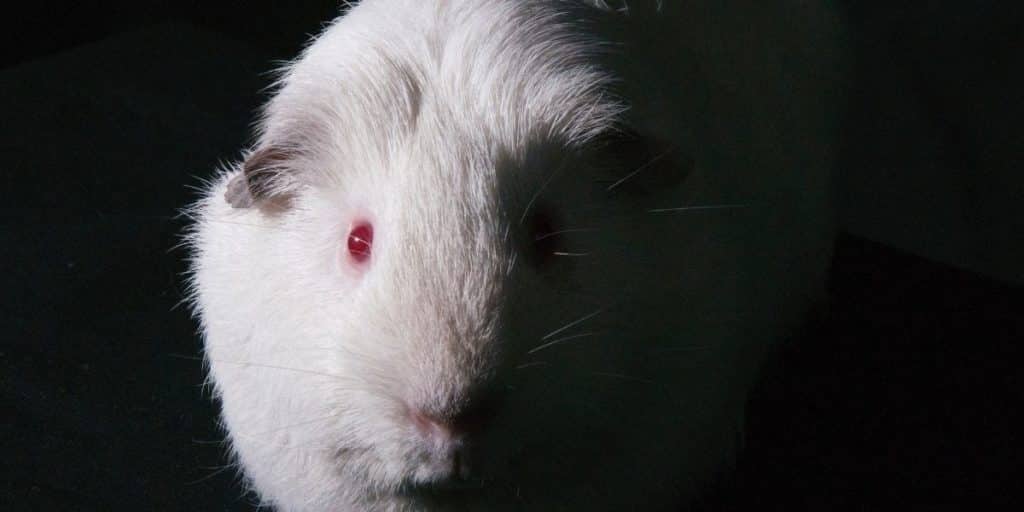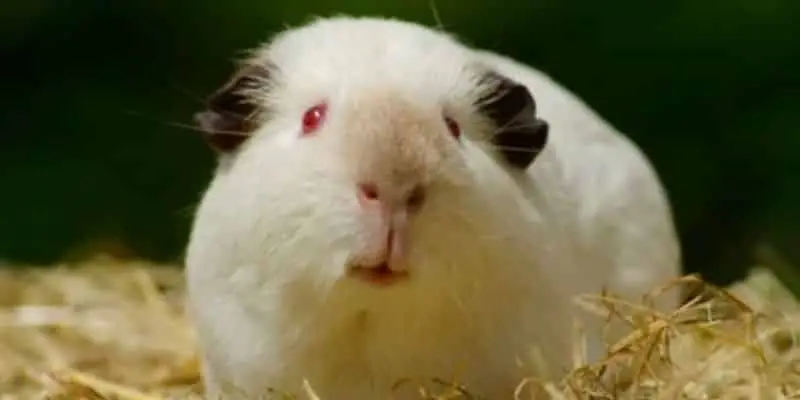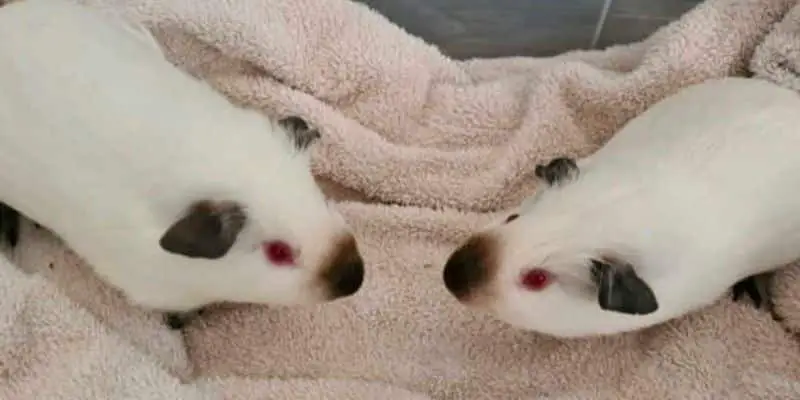
Are you considering adding a Himalayan guinea pig to your family?
They make wonderful pets, but like all animals, they require proper care. This guide will provide you with everything you need to know about caring for your Himalayan guinea pig.
From diet and exercise to housing and health care, we’ve got you covered. So read on to learn more about these charming little creatures!
Key Stats On Himalayan Guinea Pigs
Length: 8-12 Inches
Weight: 700 and 1,200 g (1.5 and 2.6 lb)
Lifespan: 5-7 years
Short Haired or Long Haired: Short Haired
Colors: White with red eyes and dark ears, feet and nose.
Temperament: Sociable, Friendly and Nervous
What is An Himalayan Guinea Pig?

The Himalayan Guinea Pig is very popular and is one of the more rare of Guinea Pig Breeds. Many people believe that they originate from Southeast Asia because of their name, however they don’t. Like many breeds they come from South America.
American Cavy Clubs and British Cavy clubs do recognise The Himalayan Guinea Pig as a breed.
You can spot an Himalayan Guinea Pig out from others, as they’re very unique in appearance. There are no other Guinea Pig Breeds that look like this one. The fact that it is unique is one of the reasons why they’re so rare.
They have red eyes and are more often than not completely white. The only colour they have is dark ears, feet and nose.
What I find really interesting is that when these guinea pigs are younger, the dark parts are lighter. This is because they get darker as they get older.
Himalayan Guinea Pig Characteristics/Appearance
Himalayan guinea pigs are shorted haired. Since they’re shorted-haired guinea pigs, it makes it much easier to groom them.
As already mentioned the coat of a Himalayan Guinea Pig is complete white with dark markings. They actually look very similar to a Siamese cat.
What is very interesting is the fact that these dark areas can actually change depending on the temperature.
If it’s cold then these dark markings do get darker and in some cases bigger. At the same time those in warmer climates, the markings tend to fade.
It’s important to try and keep your guinea pig at a consistent temperature. Like other breeds, you should try to keep them out of direct sunlight.
The Himalayan Guinea Pig appearance is very unique, which is what makes them a rare breed.
Himalayan Guinea Pig Size
Typically the Himalayan Guinea Pig will grow to be between 8-12 inches, which is pretty average compared to other breeds. They do have fairly broad shoulders and a thick body, however this could be due to the short, rough coat.
Himalayan Guinea Pig Colors
As already mentioned, the Himalayan Guinea Pig is pretty unique when it comes to its colouring. Unlike other breeds it doesn’t have mixed colours. They’re completely white with dark patches around the ears, nose and feet.
Himalayan Guinea Pig Temperament

The Himalayan Is a very friendly breed of Guinea Pig. They’ll get on with other breeds, as long as they’ve properly bonded with them. It would be a good idea to get a couple of guinea pigs at the same time, instead of just getting one and then adding a 2nd.
As long as you give them plenty of attention then they can be very loving. Like with any breed, you just need to give them time to get used to you.
They can be a little nervous to begin with, so give them plenty of tunnels or hideaways. Even though they do get frightened, they do make a great pet and once comfortable are excellent with children.
Since they are short-haired guinea pigs, they make a good breed for first time guinea pig owners.
They make great family pets
Do They Bite?
Himalayan Guinea Pigs can bite, like other guinea pigs. This is very uncommon and usually down to them being scared or just exploring. (Checkout this guide on Do Guinea Pigs Bite)
Himalayan Guinea Pig Diet
Himalayan Guinea Pigs Diet is pretty much the same food as other guinea pig breeds. I would recommend giving a daily amount of vegetables and pellets. Lettuce is always a good choice, other vegetables are good as well but you need to make sure they don’t eat too many.
The same can be said for fruits, these should be given as weekly treat.
Too much fruit and vegetables can cause them to get poorly.
Remember they are very sensitive when it comes to their diet. The main thing that you Himalayan piggy will want is hay. This should always be available. Id recommend Timothy Hay or Meadow Hay.
Himalayan Guinea Pig Care Guide
It’s really important to set up a schedule for caring for your Himalayan Guinea Pig. Like most guinea pigs, they do like routine. Below is my recommended care schedule;
Daily
- Provide Fresh Vegetables and Pellets
- Top up Timothy Hay & Fresh Bedding
- Provide Fresh Clean water
- Spot Clean The Cage
Weekly
- Fully Clean The Cage
- Brush Fur
6-10 Weeks
- Clip Nails – Add accessories to help naturally trim nails
10-12 Months
- Bathe Guinea Pigs – Required less due to them being short haired
Grooming

Since the Himalayan Guinea Pig is short-haired it doesnt require regular grooming. This is also what makes it great for first time guinea pig owners.
They’ll usually clean themselves, so you shouldn’t need to bathe them often. Although its worth noting that because they have a white coat, dirt can show up a lot more.
So they might need to be washed a little more than other short haired breeds.
Unlike long haired guinea pigs such as the Peruvian, they don’t need daily brushing. I’d recommend giving them a little brush every couple of days or at least once a week.
This will help to keep their coat smooth but also let you check for any skin conditions or parasites.
The main thing that you do is get their nails clipped every 6-10 weeks.
Himalayan Guinea Pig Lifespan
On average the lifespan of the Himalayan Guinea Pig is 5-7 years. This is the same for most guinea pig breeds.
Although they can certainly live longer than this, depending on their lifestyle and their diet.
Common Himalayan Guinea Pig Health Conditions
Himalayan Guinea Pigs can suffer the same health problems as more common breed of Guinea Pigs. Although with proper diet and care, these can be easily avoided.
A common problem that Himalayan Guineas suffer from is stress, because they are a prey animal. Stress can really impact their happiness and health. It’s important to try and put them at ease as quickly as possible, give them an area to hide and make sure you have daily holding time to get used to you.
Holding them daily will also give you the opportunity to check for any other conditions.
Some of the more common health problems include.
Vitamin C Deficiency
Himalayan Guinea Pigs like other breeds are not able to produce their own Vitamin C. It’s important that they do get this added into their diet. This will prevent them from getting a Vitamin C deficiency.
As well as fresh hay, you’ll also want to give them pellets, these are normally rich in Vitamin C. I’d also add some additional fruit and vegetables to help increase their vitamin C intake.
Symptoms of low Vitamin C can include;
- Lack of Appetite
- Diarrhea
- Rough looking Coat
Respiratory infections
Respiratory infections such as Pneumonia is something that most breeds of Guinea Pig can get. With proper care this can be easily avoided.
It’s also worth noting that stress can increase the chance of these kind of infections. So its important whilst they are young t get your new pet used to you and reduce exposure to loud noises.
Urinary Problems
Too much calcium is not good for Guinea Pigs, in fact it can cause kidney stones or a bladder infection. This can be very painful for them and even life threatening. If your Guinea Pig finds it hard to urinate or even internal bleeding, you should take them to the vet immediately.
Diarrhoea
Guinea Pigs can experience stomach issues because their digestive system is very sensitive. Feeding them the wrong things or too many treats can cause diarrhea or other digestive issues.
Keep your piggies healthy by giving them plenty of hay, pellets and a healthy amount of fruit and vegetables. You can also give them an occasional treat.
Skin Problems
If your guinea pigs are kept in a cage and not exposed to other animals then skin problems are usually uncommon. These conditions are more common in baby piggies and those that have come from pet stores.
If you notice the have itchy skin, hair loss or redness then its possible they have a fungal skin infection such as Ringworm.
Regular grooming can help you spot this.
Other Issues
There are other issues that Guinea Pigs can get, usually the same as other breeds. Since they’re born completely white part from colored spots and pink eyes, they can be susceptible to the sun. It’s fine to either keep them outside or let them have a play outside, just make sure they are not in direct sunlight.
Many of these health issues come from a poor diet. As long as you care for these excellent pets right and give them a proper diet then they shouldn’t experience any problems.
I would recommend taking them to the vet every 6-12 months for a checkup.
Exercise

It’s really important that Guinea pigs get plenty of exercise. They’re naturally herd animals and therefore like to run around together and play with others. Exercise helps keep them physically healthy but also reduces stress, making them much happier pets.
You want to give them time outside of their guinea pig cage. This will allow them to roam around and explore a new area. I’d recommend a larger play pen, so they can be safe. I find this a great time to give their cage a good clean.
Remember the Himalayan guinea pig like other guinea pigs are social pets, so why not get in the pen with them and have some cuddles.
Is The Himalayan Guinea Pig A Good Pet?
If you’re looking for a good family pet, the Himalayan Guinea Pig is a great choice. They make good sociable pets and are a distinct breed thanks to their white fur.
Since they are short-haired, they’re much easier to care for than long haired counterparts. This makes them perfect for families or those that first time guinea pig owners.
Like some other breeds, they don’t react well with the very hot climates or very cold climates. They’re also one of the breeds of guinea pigs that are better to be kept indoors.
Remember like any other guinea pig, they are herd animals so you should never keep them alone. Unless your prepared to have many of them, you should also keep them as a same sex pair.
Rescuing A Himalayan Guinea Pig
They are one of the rarer guinea pig breeds, a bit like the Peruvian guinea pig. This means that it’s very rare to find one in a rescue centre. Thats not to say it’s impossible but you might have to be very lucky. If you’ve got your heart set on this breed then you might need to try and find a breeder
How Much Does An Himalayan Guinea Pig Cost?
You should never have to pay a lot for a guinea pig, not like other animals. The price normal varies between $20 and $40. (You can often get them cheaper at rescue shelters.)
However since these are a bit rarer, you might end up spending a little more as people know there is a demand for them.
Himalayan Guinea Pig FAQ
Is The Himalayan Guinea Pig and albino breed?
Yes it is consider an albino breed, this is because of them having a predominantly white coat and pink eyes.
Why are Himalayan Guinea Pigs so rare?
They are a rare breed as they have very distinct characteristics such as the white fur that appeal to many people.
Why Do Some People Call Them The Siamese Guinea Pig?
Its not an official name for them, some have given them this nick name as they do look very similar to the siamese cat.
Final Thoughts
The Himalayan Guinea Pig is a rare breed of guinea pig that has very distinct characteristics such as the white fur that appeal to many people. They make good pets and are a distinct breed thanks to their white fur.
Since they are short-haired, they’re much easier to care for than a long coat breed.. This makes them perfect for families or those that first time guinea pig owners.
Do you have a Himalayan Guinea Pig? Let me know in the comments section!


